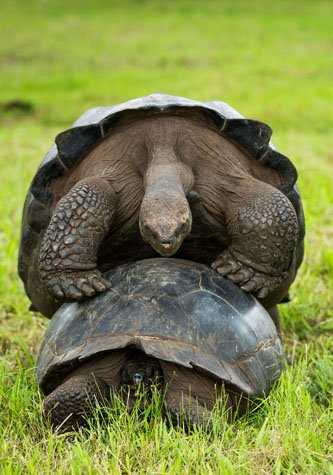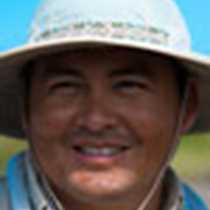Just at dawn, the National Geographic Islander entered Academy Bay in the southeastern corner of the island of Santa Cruz. It was a different view for everyone when they looked outside…civilization was here! All kinds of boats were in the harbor, from local motor-yachts of different sizes and shapes, to private sailboats most likely on their way across the Pacific Ocean in a few days.
We were exceptionally fortunate in that the morning remained overcast, so we could avoid the intense equatorial sun overhead while in town. The tortoises, as well, were probably happier and we spent the morning visiting the center operated by the Galapagos National Park. The center breeds the endangered tortoises from various islands and raises the little ones for later release back into their native homeland when large enough. This program has been underway for decades and the success of the effort is obvious. More than one race is no longer considered in danger of extinction, though we will continue to raise hatchlings for a long while until their populations can withstand future challenges.
One does not have to be a shopper to enjoy walking through town. People-watching is always entertaining, especially around the fisherman’s wharf where today’s catch was made up of yellowfin tuna, groupers and snappers. Brown pelicans competed with sea lions who confronted marine iguanas who insisted on eating meat in the middle of what seemed a chaotic scenario.
On our way up to lunch in the wonderful, cool highlands, some folks insisted on more exercise and rode mountain bikes (up-hill) the last three miles to a small local farm that grows sugar cane, coffee, bananas, papayas, cacao and probably quite a bit more on a subsistence level. For many it was an eye-opening experience to see how the juice of sugarcane is made into various products…molasses, brown sugar, and of course, moonshine. With the help of a remote-control donkey, the owner, Don Cabrera demonstrated how the cane was originally squeezed in the old days. However, for today’s larger quantities (which by other country’s standards would still be miniscule), the family now has an electric press. Fermentation follows and then distillation…and finally the hooch…which we all got to try with a good Ecuadorian toast to everyone’s health. It was also interesting to see how many people had never had the opportunity to eat a sun-ripened banana directly off the stem. This experience will unfortunately change everyone’s opinion of mass-produced bananas sold in supermarkets in the north!
Lunch was delightful in a green glade gazebo in the highlands. It was a nice chance to cool down, eat excellent fare and relax a bit. Soon enough we moved on to another bit of private property where giant tortoises of the Santa Cruz race live freely, wander freely, and throughout the year migrate up and down the slopes of the volcano at will. The tortoises follow the food supply or the opposite sex for procreation purposes.
By the end of the day we were all very happy to return to our comfortable home on the National Geographic Islander. Once onboard we had a chance to rest, enjoy drinks and hors d’ouevres and then we had dinner followed by music! The day hadn’t ended yet! Talented local musicians came onboard for one final celebration of the evening. Dancers with showy dresses accompanied the endemic tunes. Afterwards, memories, minds and SD cards were so filled, everyone had to retire to their cabins to absorb these new impressions and get ready for another new day exploring a new island.









